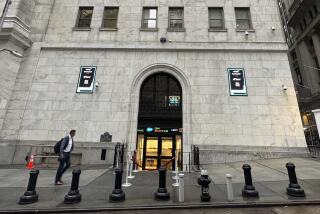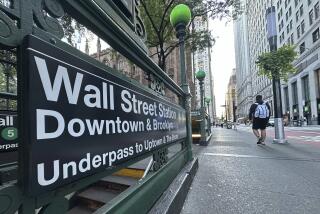Blue-Chip-Colored Glasses
A world of trouble--literally--has made for a rough-and-tumble second quarter in global financial markets.
But many Americans can be forgiven for not noticing: Judging by the blue-chip Standard & Poor’s 500 index and by Treasury bond yields, the quarter ending today looks like just another big moneymaker for U.S. investors.
The S&P; index has gained 3.3% since March 31 to a record 1,138.49 as of Monday, lifting its year-to-date advance to a stunning 17.3%.
Thirty-year T-bond yields, meanwhile, have slid from nearly 6% at the end of March to 5.64% as of Monday, dragging mortgage rates down with them and boosting bond owners’ principal values.
But that good news has masked sharp losses in the broader U.S. market this quarter, not to mention another disastrous plunge in Asian stock markets, a surge in interest rates in Russia and Latin America and a steep decline in global commodity prices that is further destabilizing already rickety emerging markets.
European stocks, like U.S. blue chips, were a bright spot in the quarter. But all in all, many Wall Street pros find more reason to be apprehensive than optimistic about the U.S. market’s third-quarter outlook.
“If I saw 6% yields on Treasury bonds again I’d be buying them on margin,” said Charles Crane, strategist at Key Asset Management in New York, reflecting on the relative appeal of bonds versus stocks today, in his view.
Then how is the S&P; 500 at a record high and the Dow Jones industrials, up 52.82 points to 8,997.36 on Monday, not far from their record of 9,211.84?
The United States and Europe clearly benefited from a flight to quality in the second quarter and the first half, as Asia’s economic crisis worsened, then infected Russia, Latin America and--last week--South Africa.
But the U.S. stock market’s gains were concentrated in a relative handful of blue chip issues in the quarter. The majority of stocks took a sharp hit beginning in April and extending into mid-June.
That was evident from the performance of the Russell 2,000 index of smaller stocks, which has fallen 5.6% so far in the second quarter, even as the S&P; 500 has rebounded to a record high.
The average small-growth-stock mutual fund lost 4.2% in the 13 weeks ended last Friday, and is up just 6.1% year-to-date--only about one-third of the gain in the blue-chip S&P.;
Many investors rushed out of smaller stocks in May as they jettisoned anything viewed as relatively illiquid--in other words, any investment they couldn’t get out of quickly.
That same desire for liquidity helped boost big-name stocks, and kept many European stock markets strong. The German stock market soared 17% in the quarter and is up 40% year-to-date.
Falling bond yields, another byproduct of the hunt for liquidity and safety, also have helped boost the relative appeal of big-name stocks.
And with Asia’s crisis far from over--and the risk still high that Japan, the biggest Asian economy of them all, could plunge into a severe deflation and depression--almost no one on Wall Street believes the Federal Reserve Board will tinker with interest rates in the near-term.
The Fed, in fact, meets today and Wednesday, and is expected to make no announcement about rates.
But even with the Fed marginalized, the U.S. stock market faces another major problem: weak corporate earnings growth, as Asian orders for U.S. goods decline and as rising wage rates here at home squeeze profit margins.
“The outlook for year-over-year earnings growth for the second quarter has now dropped to 3.6% [for the average blue-chip company] and will likely be below 3% by the time the reporting season starts in earnest” in mid-July, according to Chuck Hill of First Call, which tracks analysts’ earnings estimates.
Moreover, earnings growth is weakening as stock valuations remain near historic highs.
The U.S. stock market’s bulls, who again have had the upper hand in recent weeks as the market overall has rebounded, say concerns about 1998 earnings may soon be history.
Tom Galvin, strategist at DLJ Securities in New York, notes that “by September people will begin to price in 1999 earnings.” And with even a modest assumption of a turnaround in Asia, as well as a healthy, unified European economy in 1999, the outlook for U.S. corporate profits seems certain to improve, Galvin said.
He believes the S&P; 500-index can reach 1,350 in the next 18 months, a 19% gain from current levels.
Despite a host of worries dogging stocks in general, analysts also point out that the market is being supported in part by the greatest takeover wave in history, with the value of U.S. deals so far this year already exceeding the total for all of 1997.
Finally, there is nothing yet to suggest that the public, via mutual funds, has lost its appetite for U.S. stocks, analysts note.
(BEGIN TEXT OF INFOBOX / INFOGRAPHIC)
Wall Street Runs for Cover
Chickens, rather than bulls, seemed to dominate market action worldwide in the second quarter, which ends today. Worried by growing global market turmoil, many investors sought safety in big-name stocks in the United States and Europe, while heavy buying in Treasury bonds sent yeilds sharply lower.
*
U.S Blue Chips Hit New Highs...
Standard & Poor’s 500 index, weekly closes and latest:
Monday: 1,138.49
*
...While Most Stocks Slide
Russell 2,000 index of smaller stocks, weekly closes and latest:
Monday: 453.83
*
Asian and Latin Markets Get Slammed...
Changes in key indexes, theree month ended Monday:
-8%: Japan
-15%: India
-17%: Mexico
-19%: Brazil
-28%: Hong Kong
-34%: Singapore
-37%: Venezuela
-41%: South Korea
-44%: Pakistan
*
...While U.S. Bond Yields Slide to New Lows
30-year T-bond yield, weekly closes and latest:
Monday: 5.64%
Note: Changes in local currencies.
Source: Bloomberg News
More to Read
Inside the business of entertainment
The Wide Shot brings you news, analysis and insights on everything from streaming wars to production — and what it all means for the future.
You may occasionally receive promotional content from the Los Angeles Times.










